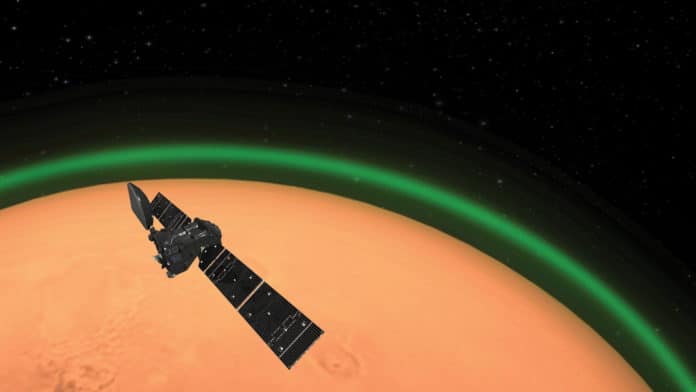Aurora is a natural electrical phenomenon characterized by the appearance of streamers of reddish or greenish light in the sky, especially near the northern or southern magnetic pole. They occurred as a result of the interaction of charged particles from the sun with atoms in the upper atmosphere.
On Earth, glowing oxygen is produced during polar auroras when energetic electrons from interplanetary space hit the upper atmosphere. The aurora, however, is just one way in which planetary atmospheres light up.
In a first such phenomenon on a planet beyond Earth, the European Space Agency’s Trace Gas Orbiter (TGO) has discovered a green light in Mars’ atmosphere. This is for the first time; such emissions have been observed around a planet other than Earth.
Jean-Claude Gérard of the Université de Liège, Belgium, said, “More specifically, from oxygen atoms emitting a particular wavelength of light that has never been seen around another planet. However, this emission has been predicted to exist at Mars for around 40 years – and, thanks to TGO, we’ve found it.”
This emission was observed by using a special observing mode of the TGO.
One of the orbiter’s advanced suite of instruments, known as NOMAD (Nadir and Occultation for Mars Discovery) and including the ultraviolet and visible spectrometer (UVIS), can observe in various configurations, one of which positions its instruments to point directly down at the martian surface – also referred to as the ‘nadir’ channel.
Co-author Ann Carine Vandaele of the Institut Royal d’Aéronomie Spatiale de Belgique, Belgium, and Principal Investigator of NOMAD said, “Previous observations hadn’t captured any green glow at Mars, so we decided to reorient the UVIS nadir channel to point at the ‘edge’ of Mars, similar to the perspective you see in images of Earth taken from the ISS.”
Between 24 April and 1 December 2019, NOMAD-UVIS was used to determine scan altitudes ranging from 20 to 400 kilometers from the martian surface twice per orbit. While examining datasets, they observed the green oxygen emission in all of them.
And Intriguingly, the emission was strongest at an altitude of around 80 kilometers and varied depending on the changing distance between Mars and the Sun.
The team wanted to understand this green glow at Mars in detail. They modeled this emission and found that it’s mostly produced as carbon dioxide (CO2), is broken up into its constituent parts: carbon monoxide and oxygen. The resulting oxygen atoms are glowing in both visible and ultraviolet light.
And when they compared these two kinds of emission, they found that the visible emission was 16.5 times more intense than the ultraviolet.
Jean-Claude said, “The observations at Mars agree with previous theoretical models but not with the actual glowing we’ve spotted around Earth, where the visible emission is far weaker. This suggests we have more to learn about how oxygen atoms behave, which is hugely important for our understanding of atomic and quantum physics.”
Håkan Svedhem, ESA’s TGO Project Scientist, said, “This is the first time this important emission has ever been observed around another planet beyond Earth and marks the first scientific publication based on observations from the UVIS channel of the NOMAD instrument on the ExoMars Trace Gas Orbiter.”
“It demonstrates the remarkably high sensitivity and optical quality of the NOMAD instrument. This is especially true given that this study explored the dayside of Mars, which is much brighter than the nightside, thus making it even more difficult to spot this faint emission.”
Journal Reference:
- Jean-Claude Gérard et al. Detection of green line emission in the dayside atmosphere of Mars from NOMAD-TGO observations, Nature Astronomy. DOI: 10.1038/s41550-020-1123-2
